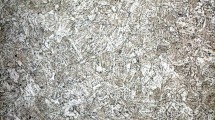Abstract
The results of an investigation to characterize the chalcopyrite/solution interface are presented. Several techniques were used, including galvanostatic and steady-state polarization, cyclic voltammetry and impedance spectroscopy. The results show that the dissolution of chalcopyrite was incongruent. Initially, at low potentials (< 0.12 V), iron species were released that led to the growth of an iron-deficient sulfide (IDS) layer (referred to as the “reacted layer” in this paper). Depending on the solution’s composition, the dissolved iron might reprecipitate as a hydroxide layer. In the potential range of 0.12 V < E < 0.23 V, the IDS layer was passivating. In comparison, development of a passivating IDS layer under galvanostatic conditions led to a jump in potential to 0.48 V. The IDS layer began to dissolve at potentials greater than 0.24 V. The dissolved species precipitated to form a product layer in alkaline solutions. Continued oxidation involved diffusion of species through the reacted and product layers. At higher potentials (> 0.48 V), further oxidation led to the dissolution of the copper and sulfur species, with a resultant breakdown of the IDS layer. The changes in surface-coating properties, resulting from various electrochemical treatments, are discussed.
Similar content being viewed by others
References
Buckley, A.N., Woods, R., 1984, “An X-ray photoelectron spectroscopic investigation of the surface oxidation of sulfide minerals,” Proceedings, International Symposium on Electrochemistry in Mineral and Metal Processing, 84-10, P.E. Richardson, S.S. Srinivasan and R. Woods, eds., The Electrochemical Society, Pennington, NJ, pp. 259–285.
Cecile, J.L., 1985, “Application of XPS in the study of sulfide mineral flotation — A review,” Flotation of Sulfide Minerals, K.S.E. Forssberg, ed., Elsevier, NY, pp. 61–80.
Chander, S., 1991, “Electrochemistry of sulfide flotation: Growth characteristics of surface coatings and their properties, with special reference to chalcopyrite and pyrite,” International Journal of Mineral Processing, Vol. 33, pp. 121–134.
Chander, S., and Gebhardt, J.E., 1989, “Application of electrochemical techniques in sulfide mineral flotation,” Challenges in Mineral Processing, K.V.S. Sastry and M.C. Fuerstenau, eds., Proceedings, a symposium honoring D.W. Fuerstenau on his 60th birthday, Berkeley, CA., December 7–9, 1988, SME, Littleton, CO, pp. 90–108.
Chander, S., and Briceno, A., 1987, “Kinetics of pyrite oxidation,” Minerals & Metallurgical Processing, Vol. 4, No. 3, pp. 171–176.
Chander, S., Briceno, A., and Pang, J., 1992, “On the mechanism of sulfur oxidation in pyrite,” Preprint 92-240, SME, Littleton, CO.
Chander, S., Pang, J., and Briceno, A., 1988, “Some equivalent circuit models for AC impedance analysis of pyrite/solution interface,” Electrochemistry in Mineral and Metal Processing, 88-21, P.E. Richardson and R. Woods, eds., The Electrochemical Society, Remington, NJ, pp. 247–263.
Das, K.K., Briceno, A., and Chander, S., 1992, “Electrochemistry of chalcopyrite flotation in the absence and presence of K-Octyl Hydroxamate,” Mineral Processing and Extractive Metallurgy Review, Vol. 8, pp. 229–243.
Gardner, J.R., and Woods, R., 1979, “A Study of the surface oxidation of galena using cyclic voltammetry,” Journal of Electroanalytical Chemistry, Vol. 100, pp. 447–459.
Guy, P.J., and Trahar, W.J., 1985, “The effects of oxidation and mineral interaction on sulfide flotation,” Flotation of Sulfide Minerals, K.S.E. Forssberg, ed., Elsevier, Amsterdam, pp. 61–79.
Hamilton, I.C., and Woods, R., 1984, “A voltammetric study of the surface oxidation of sulfide minerals,” Proceedings, International Symposium on Electrochemistry in Mineral and Metal Processing, 84-10, P.E. Richardson, S.S. Srinivasan and R. Woods, eds., The Electrochemical Society, Pennington, NJ, pp. 259–285.
Holloway, P.H., Reymond, G., and Sqartz, W.E., Jr., 1982, “Surface composition and reflectance of polished CuFeS2,” Interfacial Phenomena in Mineral Processing, B. Yarar and D.S. Spottiswood, eds., Engineering Foundation, New York, pp. 93–117.
Janetski, N.D., Woodburn, S.I., and Woods, R., 1977, “An electrochemical investigation of pyrite flotation and depression,” International Journal of Mineral Processing, Vol. 4, pp. 227–239.
Pang, J., 1988, Equivalent Circuit Models for Pyrite/solution Interface — Analysis of AC Impedance Spectra, M.S. Thesis, The Pennsylvania State University, University Park, PA.
Pang, J., and Chander, S., 1990, “Oxidation and wetting behavior of chalcopyrite in the absence and presence of xanthates,” Minerals & Metallurgical Processing, Vol. 7, pp. 149–155.
Author information
Authors and Affiliations
Additional information
SME preprint 91-153, SME Annual Meeting, Feb. 25–28, 1991, Denver, CO.
M&MP paper 91-641. Discussion of this paper must be submitted, in duplicate, prior to Nov. 30, 1992.
Rights and permissions
About this article
Cite this article
Pang, J., Chander, S. Electrochemical characterization of the chalcopyrite/solution interface. Mining, Metallurgy & Exploration 9, 131–136 (1992). https://doi.org/10.1007/BF03402984
Received:
Published:
Issue Date:
DOI: https://doi.org/10.1007/BF03402984




